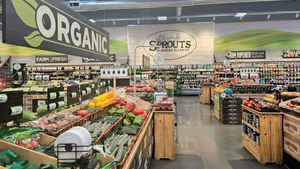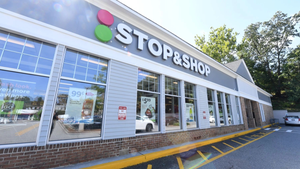Amazon Go draws high interest from U.S. shoppersAmazon Go draws high interest from U.S. shoppers
Piplsay poll finds 59% see Go cashierless stores as threat to Walmart, Kroger
February 24, 2021

Though not a direct supermarket competitor, the cashierless Amazon Go stores generate a high level of interest among Americans and could become a heady rival for the food retail dollar, according to new research from consumer opinion pollster Piplsay.
Nearly 60% of more than 30,000 U.S. adults polled online this past weekend by Piplsay would like to have an Amazon Go in their area and see the concept as a threat to big food retailers such as Walmart and Kroger. Less than a third of respondents have visited an Amazon Go location, but over half think the checkout-free format will be successful.
Seattle-based Amazon currently has 26 of the compact Amazon Go convenience stores, including eight in Manhattan, seven in Chicago, six in Seattle and five in San Francisco. The locations range in size from 1,200 to 2,700 square feet, except for one 450-square-foot, employee-only location in Seattle’s Macy’s building.
Powered by Amazon’s “Just Walk Out” technology, the Go stores use overhead cameras, weight sensors and deep learning technology to detect merchandise that shoppers take from or return to shelves and keep track of the items selected in a virtual cart. Customers use the Amazon Go mobile app to gain entry to the store through a turnstile. When they exit the store, the Just Walk Out technology automatically debits their Amazon account for the items they take and then sends a receipt to the app.

Of those polled by Piplsay, only 28% said they’ve actually gone to an Amazon Go, and 20% reported that they never heard of the store. However, 54% of consumers who visited an Amazon Go described their experience as “excellent,” and 35% thought it was “good.”
Meanwhile, 57% said they would be “excited” if an Amazon Go or similar cashierless, artificial intelligence-driven store opened in their neighborhood. Of the 26% not interested in having an Amazon Go in their area, half said they prefer regular stores and half favor online shopping. Another 17% said they’re “not sure” about the Amazon Go concept.
By gender, 54% of men said they would be excited to have Amazon Go or similar technology-enabled stores near them, compared with 46% of women.
“Amazon’s entry into the brick-and-mortar segment got a huge boost amid the pandemic, with its cashierless technology set to become the next big thing in retail,” Piplsay said in the survey report, released yesterday.
Industry observers have said Amazon Go could become a major business for Amazon as it expands its physical retail footprint. An RBC Capital Markets analysis released in January 2019 estimated average annual sales of $1.5 million apiece for the then nine Amazon Go stores. Based on a September 2018 Bloomberg report saying Amazon may open up to 3,000 Go stores in the next several years, RBC’s estimate would translate into a $4.5 billion business for the Go banner. Published reports also have said Amazon Go could pop up in new types of locations such as airports and expand to thousands of similar sites.

Citing the potential of Amazon to open thousands of Go stores, Piplsay asked consumers if such a scenario would present a competitive challenge to big-box chains such as Walmart and Kroger. Overall, 59% of respondents said Amazon Go would be a threat if it undergoes a major expansion, with 35% saying Go would present a threat “to some extent” and 24% saying it would do so “ to a big extent.”
Still, 26% of survey respondents believe Amazon Go doesn’t stand as a threat to retailers like Walmart and Kroger, Piplsay found. Fifteen percent note that Walmart and other large operators also will continue to innovate, and 11% think Walmart and other major chains are already too big for Amazon Go to present a competitive threat.
“Amazon, the world’s biggest online retailer, is all set to change the way you shop, even offline,” Piplsay observed. “With plans to open thousands of Amazon Go stores across the country in the coming years, the retail giant will not only disrupt the physical space dominated by the likes of Walmart and Kroger but will also bring the ‘Just Walk Out’ shopping experience to consumers’ doorsteps.”
Indeed, 54% of consumers told Piplsay they think Amazon Go and similar tech-powered stores will be a success as the world becomes increasingly digital, with 37% saying such stores will succeed “to some extent” and 27% “to a big extent.” Of the 18% of respondents who don’t think such store concepts will succeed, 11% reported that “not everyone is tech-savvy,” and 7% think “online is the future.”
Expectations of Amazon Go’s success as a format are about the same across generations. About 35% of Millennials and Generation Xers polled by Piplsay think Amazon Go-type stores will be a success versus 30% of Generation Zers. Also, 65% of Millenials and 60% of Gen Xers believe Amazon Go will be a threat to big brick-and-mortar retailers like Walmart and Kroger.
Amazon, though, continues to see inconsistent sales growth for its physical stores. For the fiscal 2020 fourth quarter ended Dec. 31, Amazon’s physical store sales declined 8% year over year to $4.02 billion. Full-year 2020 physical store sales fell 5.6% to $16.22 billion.
Besides the 26 Amazon Go locations, Amazon’s U.S. physical stores include 502 Whole Foods Markets, eight Amazon Fresh grocery stores, two Amazon Go Grocery stores (which use Just Walk Out cashierless technology), 24 Amazon Books stores, 29 Amazon 4-Star outlets and seven Presented by Amazon pop-up locations.
Read more about:
AmazonAbout the Author
You May Also Like



.webp?width=300&auto=webp&quality=80&disable=upscale)


